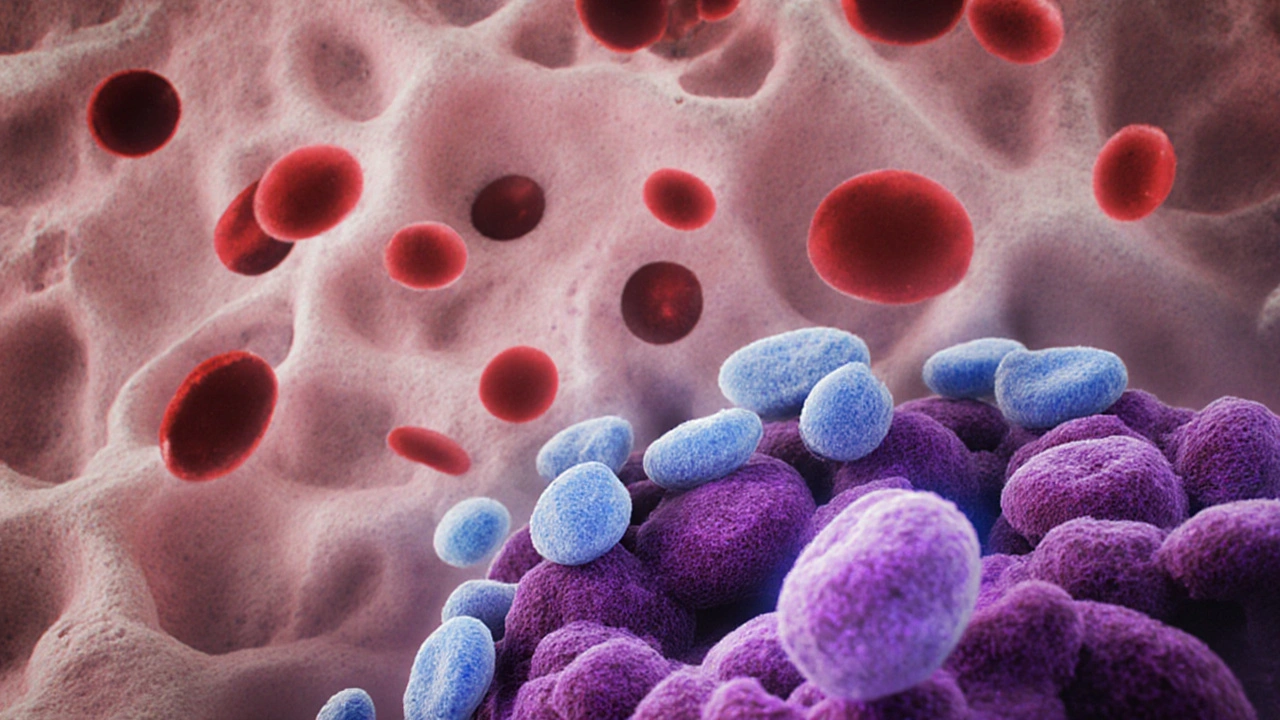
Myeloma Treatment Comparison Tool
This tool helps compare major treatment options for multiple myeloma. Select a treatment to see its typical use, key benefit, and common side effects.
| Treatment | Typical Use | Key Benefit | Common Side Effects |
|---|---|---|---|
| Proteasome Inhibitor | First-line or relapse | Rapid tumor reduction | Peripheral neuropathy, fatigue |
| Immunomodulatory Drug | Maintenance, combination regimens | Boosts immune response | Low blood counts, rash |
| Autologous Stem Cell Transplant | Eligible patients < 70 years | Deep, durable remission | Infection risk, mucositis |
| CAR T-Cell Therapy | Relapsed/refractory disease | Potential for complete response | Cytokine release syndrome, neurotoxicity |
| Chemotherapy | Bridge to transplant or trial | Broad tumor kill | Hair loss, nausea, immune suppression |
Being faced with a myeloma diagnosis can feel overwhelming, but knowing what to expect makes the journey more manageable. This guide walks you through the basics, from how the disease starts to the latest treatment options and everyday coping tips.
What Is Multiple Myeloma?
Multiple Myeloma a cancer of plasma cells that accumulate in the bone marrow is a blood‑cell cancer that primarily affects the marrow’s ability to produce healthy blood cells. Normal Plasma Cells immune cells that generate antibodies become malignant, multiply uncontrollably, and crowd out normal cells. As they grow, they produce abnormal proteins that can damage kidneys, weaken bones, and suppress the immune system.
How Is It Diagnosed?
Early detection hinges on a combination of blood tests, imaging, and marrow evaluation. Typical steps include:
- Blood work that measures M‑protein levels and checks calcium, kidney function, and blood counts (the CRAB criteria).
- Urine analysis for light chains (BenceJones protein).
- Bone‑marrow biopsy, where a needle extracts a sample for microscopic review. The sample is examined for clonal plasma cells, often using flow cytometry.
- Imaging such as whole‑body low‑dose CT or PET‑CT to spot bone lesions.
These tests together confirm the presence of malignant plasma cells and gauge disease extent, guiding treatment decisions.

Common Symptoms and Signs
Because myeloma progresses slowly, many patients notice subtle changes. Typical warning signs include:
- Unexplained bone pain, especially in the back or ribs.
- Frequent fractures from seemingly minor injuries.
- Persistent fatigue or weakness due to anemia.
- Repeated infections caused by immune suppression.
- Elevated calcium levels, leading to nausea, constipation, or confusion.
- Kidney problems manifesting as swelling, reduced urine output, or high creatinine.
Noticing these clues early can prompt testing before complications develop.
Treatment Options Overview
Therapy choices depend on disease stage, patient health, and personal preferences. Modern treatment blends several drug classes and procedures, aiming to achieve deep remission and extend survival.
Key treatment categories include:
- Proteasome Inhibitors drugs that block protein breakdown in cancer cells, causing cell death (e.g., bortezomib, carfilzomib).
- Immunomodulatory Drugs agents that stimulate the immune system and inhibit tumor growth (e.g., lenalidomide, pomalidomide).
- Autologous Stem Cell Transplant high‑dose chemotherapy followed by reinfusion of the patient’s own stem cells, often used for eligible younger patients.
- CAR T‑Cell Therapy engineered T cells that target a protein on myeloma cells, offering a one‑time cellular approach (e.g., ide‑cel).
- Traditional chemotherapy regimens, used less frequently now but still valuable in certain settings.
Below is a quick comparison to help you see the main differences.
| Treatment | Typical Use | Key Benefit | Common Side Effects |
|---|---|---|---|
| Proteasome Inhibitor | First‑line or relapse | Rapid tumor reduction | Peripheral neuropathy, fatigue |
| Immunomodulatory Drug | Maintenance, combination regimens | Boosts immune response | Low blood counts, rash |
| Autologous Stem Cell Transplant | Eligible patients < 70years | Deep, durable remission | Infection risk, mucositis |
| CAR T‑Cell Therapy | Relapsed/refractory disease | Potential for complete response | Cytokine release syndrome, neurotoxicity |
| Chemotherapy | Bridge to transplant or trial | Broad tumor kill | Hair loss, nausea, immune suppression |
Choosing the right mix often involves a multidisciplinary team, including a hematologist, oncology pharmacist, and supportive‑care specialists.

Managing Side Effects and Daily Life
Therapy can be tough, but proactive management reduces interruptions and improves quality of life. Consider these practical steps:
- Stay hydrated and monitor kidney function-many drugs increase creatinine levels.
- Use calcium‑ and vitaminD‑supplemented diets, or discuss bisphosphonate infusions (Bone Disease weakening of bones caused by myeloma lesions) to protect skeletal health.
- Report any tingling or numbness early; dose adjustments can prevent permanent nerve damage.
- Maintain a balanced diet rich in protein, fruits, and vegetables to support immune recovery.
- Schedule regular physical activity-light walking or yoga helps with fatigue and bone strength.
- Discuss mental‑health support; anxiety and depression are common, and counseling or mindfulness can be valuable.
Direct communication with your care team about side‑effect trends lets them tweak regimens before problems become severe.
Support Resources for Patients and Families
Beyond medical care, emotional and informational support makes a big difference. Here are trusted avenues:
- Clinical Trials research studies offering access to cutting‑edge therapies. Websites like ClinicalTrials.gov list open studies by location and eligibility.
- National Myeloma Society’s patient portal-offers webinars, treatment guides, and a searchable directory of specialists.
- Local or online Support Groups peer‑led meetings where patients share experiences and coping strategies. Many hospitals host monthly sessions, and virtual groups are available worldwide.
- Financial counseling services that help navigate insurance coverage, medication assistance programs, and government subsidies.
- Caregiver toolkits-checklists for medication schedules, appointment tracking, and symptom logs to keep the whole family on the same page.
Leveraging these resources eases the logistical load and provides a community that truly understands the journey.
Frequently Asked Questions
Is multiple myeloma curable?
Currently there is no definitive cure, but many patients achieve long‑term remission thanks to modern therapies. The goal is to control the disease, maintain quality of life, and extend survival.
How often should I get follow‑up tests?
After initial treatment, most specialists recommend blood work and imaging every 3-6months. Frequency may increase if symptoms change or if you’re in a clinical trial.
Can diet influence my myeloma?
A healthy diet won’t cure myeloma, but it supports immune function and kidney health. Limiting high‑protein animal sources can reduce waste products that stress the kidneys, while staying hydrated helps flush excess light chains.
What is the role of stem‑cell transplant?
The transplant allows doctors to give very high‑dose chemotherapy, wiping out more cancer cells than standard doses. After the transplant, the patient’s own stem cells repopulate the marrow, leading to deeper remission.
Are there any promising new treatments?
Yes-CART‑cell therapy and bispecific antibodies have shown high response rates in recent trials. Ongoing studies are also testing novel proteasome inhibitors and targeted small molecules.

Jessica Hakizimana
October 6, 2025 AT 13:16Facing a multiple myeloma diagnosis can feel overwhelming, but the treatment landscape is richer than ever.
Proteasome inhibitors, immunomodulatory drugs, stem‑cell transplants, and even CAR‑T therapies each offer unique pathways to remission.
Staying optimistic isn’t about ignoring the challenges; it’s about recognizing that science is constantly advancing and that many patients achieve deep, lasting responses.
Keep leaning on your medical team, ask about clinical trials, and remember that every step forward, no matter how small, is a victory worth celebrating.
peter derks
October 8, 2025 AT 20:49One of the best things you can do right now is to build a solid support network.
Talk openly with your oncologist about the pros and cons of each option, and enlist a caregiver or friend to attend appointments so you don’t miss essential details.
Staying organized with a treatment calendar and keeping a symptom journal can make a huge difference when adjusting therapies.
Remember, you’re not alone in this journey-lean on the community and keep the momentum going.
Sarah DeMaranville
October 11, 2025 AT 04:23All those glossy treatment charts? Just marketing fluff.
Edward Leger
October 13, 2025 AT 11:56When we confront a disease like multiple myeloma, we’re reminded of the fragile balance between life’s impermanence and medical ambition.
The choice of therapy becomes a dialogue between the body’s resilience and the science that seeks to amplify it.
In quiet moments, reflecting on this interplay can bring a sense of calm amid the clinical bustle.
Keyla Garcia
October 15, 2025 AT 19:29Oh honey, the treatment table looks like a runway of drama! 😱
Proteasome inhibitors strut in with “rapid tumor reduction” while side‑effects like peripheral neuropathy whisper sabotage.
Immunomodulatory drugs claim to “boost the immune response,” yet low blood counts crash the party.
And don’t even get me started on CAR‑T cell therapy – it’s the diva of the lineup, promising complete response but delivering cytokine storms that could melt your face off. 😈
Choose wisely, darling, because this isn’t just a medical decision; it’s a full‑blown saga.
Ismaeel Ishaaq
October 18, 2025 AT 03:03Listen up, warriors! 🎨 The arsenal against multiple myeloma is nothing short of a vibrant kaleidoscope of possibilities.
Proteasome inhibitors slam the cancer cells with a thunderbolt of rapid reduction, while immunomodulatory drugs dance like fireworks, rallying your immune troops.
Stem‑cell transplants? They’re the phoenix, rising from the ashes with deep, durable remission.
And when you throw CAR‑T therapy into the mix, you’re unleashing a ferocious tsunami of cellular artillery that can wipe out the refractory rebels.
Don’t let side‑effects intimidate you; treat them as battle scars that prove you’re still standing.
Charge forward with confidence, because the science is on your side and the victory is within reach!
Jesse Goodman
October 19, 2025 AT 20:43Glad you caught the drama, 😂.
Antara Kumar
October 21, 2025 AT 22:43While the guide touts cutting‑edge therapies, it glosses over the stark reality that many patients in developing nations lack even basic access to these options. A truly comprehensive guide should address global disparities, not just the idealized American treatment armamentarium.
John Barton
October 24, 2025 AT 00:43Oh great, another “complete guide” that pretends to demystify multiple myeloma while secretly whispering that you need a PhD to understand the tables. Yeah, because we all have time to decode side‑effect jargon between chemo sessions.
Achint Patel
October 25, 2025 AT 18:23Sounds like you’re channeling the inner cynic, John, but let’s break it down: the table isn’t a cryptic puzzle, it’s a concise snapshot of treatment trajectories.
Each column-typical use, key benefit, side effects-maps directly to clinical decision points.
When you strip away the drama, you see a practical tool for patients to compare options without PhD‑level cryptanalysis.
So, enjoy the clarity, not the melodrama.
Lilly Merrill
October 27, 2025 AT 19:23It’s heartening to see a resource that respects both medical rigor and the personal stories behind each treatment choice. By presenting the data in a clear layout, families from diverse backgrounds can find common ground and make informed decisions together.
Charlie Martin
October 29, 2025 AT 21:23Just a heads‑up: if you’re considering autologous stem‑cell transplant, be prepared for a rigorous pre‑screening process and potential delays due to insurance approvals.
Danielle Watson
October 31, 2025 AT 15:03good tip but also check the transplant center's success rates they vary widely
Kimberly :)
November 2, 2025 AT 17:03Sure, the table looks neat, but remember that every patient’s journey is a unique puzzle 🧩. Stats can’t capture the lived experience, so keep asking questions and trust your gut 😊.
Sebastian Miles
November 4, 2025 AT 19:03From a hematology standpoint, integrating a proteasome inhibitor with an immunomodulatory agent can achieve synergistic cytoreduction, especially in early‑relapse settings.
Harshal Sanghavi
November 6, 2025 AT 12:43Right, because nothing says “support” like tossing jargon at someone already juggling side‑effects.
Duke Gavrilovic
November 8, 2025 AT 20:16This guide succeeds in demystifying a disease that often feels cloaked in medical obscurity.
By laying out each therapeutic class side by side, it gives patients and families a roadmap they can actually follow.
The inclusion of typical use, key benefit, and side‑effect columns respects the need for both scientific detail and practical relevance.
Moreover, the interactive tool invites users to engage actively rather than passively reading static text.
For newcomers, the clear headings alleviate the intimidation that dense oncology literature can impose.
For seasoned survivors, the comparison table offers a quick refresher that can inform conversations with their care team.
It is commendable that the authors did not shy away from listing uncomfortable side‑effects such as neuropathy and cytokine release syndrome.
Transparency in this regard builds trust and prepares patients for the realities of each regimen.
The suggestion to explore clinical trials is especially prudent, as emerging modalities like bispecific antibodies are reshaping the treatment landscape.
While the guide is thorough, a modest addition could be a brief section on financial navigation resources, which many patients find crucial.
In my experience, pairing medical information with advocacy contacts dramatically improves outcomes.
The tone strikes a balance between professional authority and compassionate accessibility, which is no small feat.
Readers from diverse cultural backgrounds will appreciate the neutral language that avoids jargon overload.
Finally, the tool’s design is responsive and user‑friendly, ensuring that even those with limited tech experience can benefit.
All in all, this is a valuable resource that empowers informed decision‑making and fosters hope amidst uncertainty.
Keep revisiting the guide as new therapies emerge, because staying informed is the best defense you have.